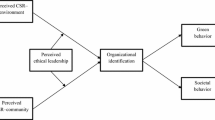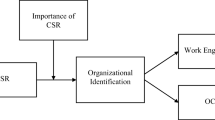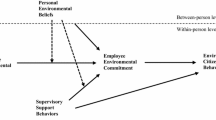Abstract
Scholarly interest in employees’ voluntary pro-environmental behavior has begun to emerge. While this research is beginning to shed light on the predictors of workplace pro-environmental behavior, our understanding of the psychological mechanisms linking the various antecedents to employees’ environmentally responsible behavior and the circumstances under which any such effects are enhanced and/or attenuated is incomplete. The current study seeks to fill this gap by examining: (a) the effects of perceived corporate social responsibility on employees’ voluntary pro-environment behavior; (b) an underlying mechanism that links CSR perceptions to these behaviors; and (c) a boundary condition to these relationships. Data from 183 supervisor-subordinate dyads employed in large- and medium-sized casinos and hotels in Guangdong China and Macau revealed that employees’ corporate social responsibility perceptions indirectly affect their engagement in voluntary pro-environmental behavior through organizational identification, and these effects are stronger for employees high in empathy.



Similar content being viewed by others
Notes
It is important to note that empathy is conceptually similar to, yet distinct from, third-party justice judgments (i.e., innate moral and emotional reactions—usually anger- to the perceived unfair treatment of others; Rupp 2011). Specifically, both consist of cognitive and emotional components. That is, feeling empathy and experiencing third-party justice judgments both involve drawing one’s attention to some wrongful event (i.e., cognitive component) and exacerbating feelings toward the event (i.e., emotional component).
References
Aguinis, H., & Glavas, A. (2012). What we know and don’t know about corporate social responsibility a review and research agenda. Journal of Management, 38(4), 932–968.
Andersson, L., Jackson, S. E., & Russell, S. V. (2013). Greening organizational behavior: An introduction to the special issue. Journal of Organizational Behavior, 34(2), 151–155.
Ashforth, B. E., Harrison, S. H., & Corley, K. G. (2008). Identification in organizations: An examination of four fundamental questions. Journal of Management, 34(3), 325–374.
Ashforth, B. E., & Mael, F. (1989). Social identity theory and the organization. Academy of Management Review, 14(1), 20–39.
Bagozzi, R. P. (2003). Positive and negative emotions in organizations. Positive Organizational Scholarship: Foundations of a New Discipline, 12, 176–193.
Bartel, C. A. (2001). Social comparisons in boundary-spanning work: Effects of community outreach on members’ organizational identity and identification. Administrative Science Quarterly, 46(3), 379–413.
Batson, C. D. (1990). Self-report ratings of empathic emotion. In N. Eisenberg & J. Strayer (Eds.), Empathy and its development (pp. 356–360). New York: Cambridge University Press.
Batson, C. D. (2008). Empathy-induced altruism motivation. Paper presented at the inaugrual Herzliya symposium on “prosocial motives, emotions and beavior”, Herzliya, Israel.
Batson, C. D. (2009). These things called empathy: Eight related but distinct phenomena. In J. Decety & W. Ickes (Eds.), The social neuroscience of empathy (pp. 3–15). Cambridge, MA: MIT Press.
Batson, C. D., & Shaw, L. L. (1991). Encouraging words concerning the evidence for altruism. Psychological Inquiry, 2(2), 159–168.
Berenguer, J. (2007). The effect of empathy in proenvironmental attitudes and behaviors. Environment and Behavior, 39(2), 269–283.
Berenguer, J. (2008). The effect of empathy in environmental moral reasoning. Environment and Behavior, 42(1), 110–134.
Bissing-Olson, M., Iyer, A., Fielding, S., & Zacher, H. (2013). Relationships between daily affect and pro-environmental behavior at work: The moderating role of pro-environmental attitude. Journal of Organizational Behavior, 34(2), 156–175.
Boiral, O. (2009). Greening the corporation through organizational citizenship behaviors. Journal of Business Ethics, 87(2), 221–236.
Boiral, O., & Paillé, P. (2012). Organizational citizenship behavior for the environment: Measurement and validation. Journal of Business Ethics, 109(4), 431–445.
Bolino, M. C., Varela, J. A., Bande, B., & Turnley, W. H. (2006). The impact of impression management tactics on supervisor ratings of organizational citizenship behavior. Journal of Organizational Behavior, 27(3), 281–297.
Brammer, S., He, H., & Mellahi, K. (2014). Corporate social responsibility, employee organizational identification, and creative effort: The moderating impact of corporate ability. Group and Organization Management, 40(3), 323–352.
Brammer, S., Millington, A., & Rayton, B. (2007). The contribution of corporate social responsibility to organizational commitment. The International Journal of Human Resource Management, 18(10), 1701–1719.
Brammer, S. J., & Pavelin, S. (2006). Corporate reputation and social performance: The importance of fit. Journal of Management Studies, 43(3), 435–455.
Brislin, R. W. (1980). Translation and content analysis of oral and written material. Handbook of Cross-cultural Psychology, 2(2), 349–444.
Cantor, D. E., Morrow, P. C., & Montabon, F. (2012). Engagement in environmental behaviors among supply chain management employees: An organizational support theoretical perspective. Journal of Supply Chain Management, 48(3), 33–51.
Carmeli, A., Gilat, G., & Waldman, D. A. (2007). The role of perceived organizational performance in organizational identification, adjustment and job performance. Journal of Management Studies, 44(6), 972–992.
Chen, Z., Li, H., & Wong, C. T. (2002). An application of bar-code system for reducing construction wastes. Automation in Construction, 11(5), 521–533.
Chen, X., Peterson, M., Hull, V., Lu, C., Lee, G. D., Hong, D., et al. (2011). Effects of attitudinal and sociodemographic factors on pro-environmental behavior in urban China. Environmental Conservation, 38(1), 45–52.
Davis, M. H. (1983). Measuring individual differences in empathy: Evidence for a multidimensional approach. Journal of Personality and Social Psychology, 44(1), 113.
De Roeck, K., El Akremi, A., & Swaen, V. (2016). Consistency matters! How and when does corporate social responsibility affect employees’ organizational identification? Journal of Management Studies. doi:10.1111/joms.12216.
Detert, J. R., Treviño, L. K., & Sweitzer, V. L. (2008). Moral disengagement in ethical decision making: A study of antecedents and outcomes. Journal of Applied Psychology, 93(2), 374.
Dietz, J., & Kleinlogel, E. P. (2014). Wage cuts and managers’ empathy: How a positive emotion can contribute to positive organizational ethics in difficult times. Journal of Business Ethics, 119(4), 461–472.
Duan, C., & Hill, C. E. (1996). The current state of empathy research. Journal of Counseling Psychology, 43(3), 261.
Dutton, J. E., Dukerich, J. M., & Harquail, C. V. (1994). Organizational images and member identification. Administrative Science Quarterly, 39(2), 239–263.
Edwards, M. R. (2009). HR, perceived organisational support and organisational identification: An analysis after organisational formation. Human Resource Management Journal, 19(1), 91–115.
Erdogan, B., Bauer, T. N., & Taylor, S. (2015). Management commitment to the ecological environment and employees: Implications for employee attitudes and citizenship behaviors. Human Relations, 68(11), 1669–1691.
Farooq, O., Rupp, D., & Farooq, M. (2016). The multiple pathways through which internal and external corporate social responsibility influence organizational identification and multifoci outcomes: The moderating role of cultural and social orientations. Academy of Management Journal. doi:10.5465/amj.2014.0849.
Flannery, B. L., & May, D. R. (2000). Environmental ethical decision making in the U.S. metal-finishing industry. Academy of Management Journal, 43(4), 642–662.
Glavas, A., & Godwin, L. N. (2013). Is the perception of ‘goodness’ good enough? Exploring the relationship between perceived corporate social responsibility and employee organizational identification. Journal of Business Ethics, 114(1), 15–27.
Graves, L. M., Sarkis, J., & Zhu, Q. (2013). How transformational leadership and employee motivation combine to predict employee proenvironmental behaviors in China. Journal of Environmental Psychology, 35, 81–91.
Haslam, S. A., & Ellemers, N. (2005). Social identity in industrial and organizational psychology: Concepts, controversies and contributions. International Review of Industrial and Organizational Psychology, 20(1), 39–118.
Hatcher, S. L., Nadeau, M. S., Walsh, L. K., Reynolds, M., Galea, J., & Marz, K. (1994). The teaching of empathy for high school and college students: Testing Rogerian methods with the Interpersonal Reactivity Index. Adolescence, 29(116), 961.
Hayes, A. F. (2013). Introduction to mediation, moderation, and conditional process analysis: A regression-based approach. New York: Guilford Press.
Hofman, P. S., & Newman, A. (2014). The impact of perceived corporate social responsibility on organizational commitment and the moderating role of collectivism and masculinity: Evidence from China. The International Journal of Human Resource Management, 25(5), 631–652.
Holland, R. W., Aarts, H., & Langendam, D. (2006). Breaking and creating habits on the working floor: A field-experiment on the power of implementation intentions. Journal of Experimental Social Psychology, 42(6), 776–783.
Jones, D. A. (2010). Does serving the community also serve the company? Using organizational identification and social exchange theories to understand employee responses to a volunteerism programme. Journal of Occupational and Organizational Psychology, 83(4), 857–878.
Jones, D. A., Willness, C. R., & Madey, S. (2014). Why are job seekers attracted by corporate social performance? Experimental and field tests of three signal-based mechanisms. Academy of Management Journal, 57(2), 383–404.
Kennedy, S., Whiteman, G., & Williams, A. (2015). Sustainable innovation at interface: Workplace pro-environmental behavior as a collective driver for continuous improvement. In J. L. Robertson & J. Barling (Eds.), The psychology of green organizations (pp. 351–377). New York: Oxford University Press.
Kim, A., Kim, Y., Han, K., Jackson, S. E., & Ployhart, R. E. (2014). Multilevel influences on voluntary workplace green behavior: Individual differences, leader behavior, and coworker advocacy. Journal of Management. doi:10.1177/0149206314547386.
Kim, H. R., Lee, M., Lee, H. T., & Kim, N. M. (2010). Corporate social responsibility and employee–company identification. Journal of Business Ethics, 95(4), 557–569.
Korschun, D., Bhattacharya, C. B., & Swain, S. D. (2014). Corporate social responsibility, customer orientation, and the job performance of frontline employees. Journal of Marketing, 78(3), 20–37.
Lamm, E., Tosti-Kharas, J., & King, C. E. (2015). Empowering employee sustainability: Perceived organizational support toward the environment. Journal of Business Ethics, 128(1), 207–220.
Lamm, E., Tosti-Kharas, J., & Williams, E. G. (2013). Read this article, but don’t print it: Organizational citizenship behavior toward the environment. Group and Organization Management, 38(2), 163–197.
Lamond, D., Dwyer, R., Arendt, S., & Brettel, M. (2010). Understanding the influence of corporate social responsibility on corporate identity, image, and firm performance. Management Decision, 48(10), 1469–1492.
Mael, F., & Ashforth, B. E. (1992). Alumni and their alma mater: A partial test of the reformulated model of organizational identification. Journal of Organizational Behavior, 13(2), 103–123.
Mencl, J., & May, D. R. (2009). The effects of proximity and empathy on ethical decision-making: An exploratory investigation. Journal of Business Ethics, 85(2), 201–226.
Morgeson, F. P., Aguinis, H., Waldman, D. A., & Siegel, D. S. (2013). Extending corporate social responsibility research to the human resource management and organizational behavior domains: A look to the future. Personnel Psychology, 66(4), 805–824.
Muller, A. R., Pfarrer, M. D., & Little, L. M. (2014). A theory of collective empathy in corporate philanthropy decisions. Academy of Management Review, 39(1), 1–21.
Newman, A., Miao, Q., Hofman, P. S., & Zhu, C. J. (2016). The impact of socially responsible human resource management on employees’ organizational citizenship behavior: The mediating role of organizational identification. The International Journal of Human Resource Management, 27(4), 440–455.
Nishii, L. H., Lepak, D. P., & Schneider, B. (2008). Employee attributions of the “why” of HR practices: Their effects on employee attitudes and behaviors, and customer satisfaction. Personnel Psychology, 61(3), 503–545.
Norton, T. A., Parker, S. L., Zacher, H., & Ashkanasy, N. M. (2015). Employee green behavior: A theoretical framework, multilevel review, and future research agenda. Organization & Environment, 28(1), 103–125.
Norton, T. A., Zacher, H., & Ashkanasy, N. M. (2014). Organizational sustainability policies and employee green behavior: The mediating role of work climate perceptions. Journal of Environmental Psychology, 38, 49–54.
Orlitzky, M., Schmidt, F. L., & Rynes, S. L. (2003). Corporate social and financial performance: A meta-analysis. Organization Studies, 24(3), 403–441.
Paillé, P., Chen, Y., Boiral, O., & Jin, J. (2014). The impact of human resource management on environmental performance: An employee-level study. Journal of Business Ethics, 121(3), 451–466.
Paillé, P., & Raineri, N. (2015). Linking corporate policy and supervisory support with environmental citizenship behaviors: The role of employee environmental beliefs and commitment. Journal of Business Ethics. doi:10.1007/s10551-015-2548-x.
Podsakoff, P. M., MacKenzie, S. B., & Podsakoff, N. P. (2012). Sources of method bias in social science research and recommendations on how to control it. Annual Review of Psychology, 63, 539–569.
Preacher, K. J., Rucker, D. D., & Hayes, A. F. (2007). Addressing moderated mediation hypotheses: Theory, methods, and prescriptions. Multivariate Behavioral Research, 42(1), 185–227.
Ramus, C. A., & Steger, U. (2000). The roles of supervisory support behaviors and environmental policy in employee eco-initiatives at leading-edge European companies. Academy of Management Journal, 43(4), 605–626.
Riketta, M. (2005). Organizational identification: A meta-analysis. Journal of Vocational Behavior, 66(2), 358–384.
Robertson, J. L., & Barling, J. (2013). Greening organizations through leaders’ influence on employees’ pro-environmental behaviors. Journal of Organizational Behavior, 34(2), 176–194.
Robertson, J. L., & Barling, J. (2015). Introduction. In J. L. Robertson & J. Barling (Eds.), The psychology of green organizations (pp. 3–11). New York: Oxford University Press.
Rupp, D. E. (2011). An employee-centered model of organizational justice and social responsibility. Organizational Psychology Review, 1(1), 72–94.
Rupp, D. E., Shao, R., Thornton, M. A., & Skarlicki, D. P. (2013). Applicants’ and employees’ reactions to corporate social responsibility: The moderating effects of first-party justice perceptions and moral identity. Personnel Psychology, 66(4), 895–933.
Schultz, P. W. (2000). Empathizing with nature: Toward a social-cognitive theory of environmental concern. Journal of Social Issues, 56, 391–406.
Schultz, P. W. (2001). Assessing the structure of environmental concern: Concern for self, other people and the biosphere. Journal of Environmental Psychology, 21(4), 1–13.
Servaes, H., & Tamayo, A. (2013). The impact of corporate social responsibility on firm value: The role of customer awareness. Management Science, 59(5), 1045–1061.
Shen, Z., Liu, X., & Zhou, X. (2008). Research on state-owned enterprise reform: In view of social responsibility. China Industrial Economics, 9, 141–149.
Stanwick, P. A., & Stanwick, S. D. (1998). The relationship between corporate social performance, organizational size, financial performance, and environmental performance: An empirical examination. Journal of Business Ethics, 17(2), 195–204.
Tajfel, H., & Turner, J. C. (1986). The social identity theory of intergroup behavior. S. Worchel, 8, 7–24.
Tam, V. W. Y., & Tam, C. M. (2008). Waste reduction through incentives: A case study. Building Research & Information, 36(1), 37–43.
Tian, Q., Liu, Y., & Fan, J. (2015). The effects of external stakeholder pressure and ethical leadership on corporate social responsibility in China. Journal of Management & Organization, 21(4), 388–410.
Turker, D. (2009). Measuring corporate social responsibility: A scale development study. Journal of Business Ethics, 85(4), 411–427.
Valentine, S., & Fleischman, G. (2008). Ethics programs, perceived corporate social responsibility and job satisfaction. Journal of Business Ethics, 77(2), 159–172.
Van Dyne, L., & Pierce, J. L. (2004). Psychological ownership and feelings of possession: Three field studies predicting employee attitudes and organizational citizenship behavior. Journal of Organizational Behavior, 25(4), 439–459.
Van Houten, R. V., Nau, P. A., & Merrigan, M. (1981). Reducing elevator energy use: A comparison of posted feedback and reduced elevator convenience. Journal of Applied Behavior Analysis, 14(4), 377–387.
Verbeke, W., & Bagozzi, R. P. (2002). A situational analysis on how salespeople experience and cope with shame and embarrassment. Psychology & Marketing, 19(9), 713–741.
Vlachos, P. A., Panagopoulos, N. G., & Rapp, A. A. (2014). Employee judgments of and behaviors toward corporate social responsibility: A multi-study investigation of direct, cascading, and moderating effects. Journal of Organizational Behavior, 35(7), 990–1017.
Author information
Authors and Affiliations
Corresponding author
Appendix
Appendix
Abbreviated CSR Scale (Turker 2009)
-
1.
Our company participates in activities, which aim to protect and improve the quality of the natural environment.
-
2.
Our company makes investment to create a better life for future generations.
-
3.
Our company implements special programs to minimize its negative impact on the natural environment.
-
4.
Our company targets sustainable growth, which considers future generations.
-
5.
Our company supports nongovernmental organizations working in problematic areas.
-
6.
Our company contributes to campaigns and projects that aim to promote the well-being of the society.
-
7.
Our company encourages its employees to participate in voluntary activities.
-
8.
Our company respects consumer rights beyond the legal requirements.
-
9.
Our company provides full and accurate information about its product to its customers.
-
10.
Customer satisfaction is highly important for our company.
-
11.
Our company always pays its taxes on a regular and continuing basis.
-
12.
Our company complies with legal regulations completely and promptly.
Abbreviated Empathy Scale (Dietz and Kleinlogel 2014)
-
1.
I sometimes find it difficult to see things from the ‘‘other guy’s’’ perspective.
-
2.
I sometimes try to understand my friends better by imagining how things look from their perspective.
-
3.
When I’m upset at someone, I usually try to ‘‘put myself in his shoes’’ for a while.
-
4.
Before criticizing somebody, I try to imagine how I would feel if I were in their place.
-
5.
I often have tender, concerned feelings for people less fortunate than me.
-
6.
Sometimes I don’t feel very sorry for other people when they are having problems.
-
7.
When I see someone being taken advantage of, I feel kind of protective toward them.
-
8.
Other people’s misfortunes do not usually disturb me a great deal.
-
9.
When I see someone being treated unfairly, I sometimes don’t feel very much pity for them.
-
10.
I am often quite touched by things I see happen.
Rights and permissions
About this article
Cite this article
Tian, Q., Robertson, J.L. How and When Does Perceived CSR Affect Employees’ Engagement in Voluntary Pro-environmental Behavior?. J Bus Ethics 155, 399–412 (2019). https://doi.org/10.1007/s10551-017-3497-3
Received:
Accepted:
Published:
Issue Date:
DOI: https://doi.org/10.1007/s10551-017-3497-3




